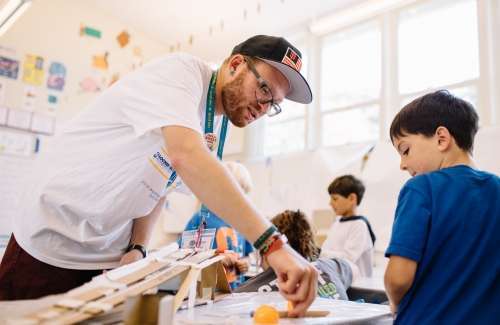With many families spending more time at home, chores are more important than ever—both for maintaining a household and for teaching kids responsibility. While the benefits of sharing the load are clear, that doesn’t mean it’s always easy to get everyone in the household on board. After all, if you ask most kids about their idea of fun, you’re unlikely to hear words like “chores” or “housework” come up all that often.
We spoke to two professional educators and camp directors to see what tips they have for taking cajoling and pleading out of the equation. Here are six ways to revamp your family’s everyday routines.
#1: Set the tone.
Parisa, a Galileo camp director and longtime educator, is no stranger to getting kids excited about pitching in.
“Introducing activities with energy and enthusiasm goes a very long way,” Parisa says. It’s a lot easier to get kids on board when the prospect isn’t an occasion to groan and drag feet, but rather an exciting adventure—or at least a family activity. Or, as Parisa puts it, “If you’re excited, your kids are much more likely to be excited, too.”
Parisa also suggests being intentional about how adults frame must-do activities. For example, phrasing a task as something you’re all going to do together rather than asking kids if they’re willing to help out can lay a stronger foundation. “Spoiler alert: If you phrase a chore or activity as an invitation, then they can say ‘no.’”
#2: Know (and share) the why.
Curiosity is an essential part of a child’s development. To get kids truly bought into specific chores, explaining the why behind the action is essential.
“Be honest about why a chore needs to be done in the first place,” suggests Sheighlin, a classroom teacher and camp director with a background in behavioral therapy. “Kids love to know the reasoning behind why they are being asked to do something. It gives the task more meaning and makes them feel important!”
Still meeting resistance? Sheighlin recommends bringing kids in as partners in the household. “Phrasing a request like you really need their help to do something because they are so good at x, y, and z will empower and motivate them to show what they can do.”
#3: Pump up the jams.
Many parents are familiar with the benefits of the five-minute warning. Giving a little heads up can support kids in understanding what’s on deck and making the transition to what comes next. For transition time that’s as enjoyable as it is utilitarian, all you need is a little music.
“Putting on favorite songs as time restraints can help keep kids on track in a very fun way,” Parisa says. To test it out, pull up a familiar tune and challenge the crew to put away school supplies or complete their bedtime routine before the track ends. If you’re not sure how to introduce this idea, try something direct and encouraging, like: “When the song ends, all pajamas are one and teeth are brushed! I know you can do it!”
The beat doesn’t stop there. On chore-heavy days, consider designating a family DJ. “Maybe you choose your favorite band as a theme, and you have it playing throughout the day as you do chores together,” Parisa suggests. This not only makes cleaning the kitchen much more fun: it also gives family members an opportunity to share things they love and learn more about one another.
#4: Scale appropriately.
Just because one child is older doesn’t necessarily mean they get more time on a chore or task. Instead, consider how they might do that task in a different way.
“In my classroom,” Sheighlin illustrated, “when I have students who are ready for more difficulty in math, I don’t give them more problems. I give them the same amount of work, but the problems are different or more advanced.”
The same is true at home. In the example of cleaning a room, a younger child may be ready to pick everything off the floor while an older child may be capable of using the vacuum cleaner.
“Teach them and explain that it’s because they are ready for that responsibility, not necessarily more responsibility, Sheighlin recommends. “Same amount of time on similar tasks in different ways!”
#5: Bring the fun.
What do you do when the toys strewn across the floor can’t go any longer without being picked up, but your child just isn’t having it? Come to think of it, what do you do when the dishes pile up and YOU just aren’t having it? Aligning on a system can help everyone press on when motivation runs low.
Sheighlin recommends turning chores into games. This can be pretty direct for kids—Chore Olympics or laundry hamper basketball, anyone?—but it works for adults, too. “The next time you have a chore you really need to get done but can’t muster up the motivation to cross off the list, ask your kids to come up with a game that you will play,” Sheighlin suggests. This removes the dread while also setting a positive example for the whole family.
Looking for something a little different? “We use a sticker chart in my classroom, which is especially helpful for students who need some extrinsic motivation,” says Sheighlin. Part of the beauty of a sticker chart is that it’s a visual reminder of how much has been accomplished, helping everyone on the board get excited about the progress they’re making towards a goal.
#6: Be in it together.
When tensions run high, explicitly rooting for the people you love can be a powerful gesture. Sometimes, that can show up pretty literally.
“I’ve seen it done in the classroom where everyone splits up to do their chore or job,” Sheighlin recounts. “Once they finish, instead of making it a race or competition, they go over to whoever is still working and either cheer them on or offer to help. In the end, everyone is cheering and excited that they finished the task. The end result is a celebration of collaboration as much as it is individual successes.”
And of course, behind that encouragement is love for one another. How might you find ways to let that love breathe?
“With everything that families are navigating, we can’t all be game masters and creators everyday,” Parisa reminds. “It’s important to be kind and gentle towards one another, and towards ourselves.”





